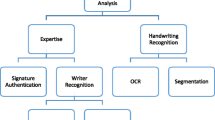Abstract
Chinese language has enormous number of characters and complicated stroke structures. So it is very difficult to efficiently and accurately identify a Chinese writer from his/her handwritings. This paper proposes a novel writer identification method for Chinese characters commonly used in Japan which can be used in peer-to-peer (P2P) systems. As a preliminary task, we have analyzed the shapes of strokes and the types of block division structures in Chinese characters and selected some characters for writer identification. The method consists of two efficient algorithms, i.e. the Hidden-feature analysis and the Block-type model, which respectively utilize intra-stroke and inter-stroke features of handwritings to enhance the writer identification accuracy. The Hidden-feature analysis makes template classes of reference characters with online features of training samples such as pen-pressure, pen-speed, pen-altitude, and pen-azimuth of each stroke. The Block-type model also creates such classes for writer identification based on offline features, i.e. the positional information about blocks of sample characters. The experimental results show that the Hidden-feature analysis requires eight Chinese characters while the Block-type model requires only four characters and four ones to achieve writer identification accuracy over 98%. Additionally, the results also demonstrate that any eight Chinese characters are enough to achieve an identification accuracy over 99.9% when the combination of the two algorithms is applied.













Similar content being viewed by others
References
Han J (2015) Distributed hybrid P2P networking systems. Peer-to-Peer Networking Appl 8(4):555–556
Jiang Q, Lu X, Tian Y (2015) An efficient two-factor user authentication scheme with unlinkability for wireless sensor networks. Peer-to-Peer Networking Appl 8(6):1070–1081
Mun H-J, Han K-H (2016) Blackhole attack: user identity and password seize attack using honeypot. J Comput Virology Hacking Tech 12(3):185–190
Wu F, Xu L, Kumari S, Li X (2016) An improved and provably secure three-factor user authentication scheme for wireless sensor networks. Peer-to-Peer Networking and Applications, https://doi.org/10.1007/s12083-016-0485-9. August (first published online)
Yan Y, Chen C, Deng W, Yuan F (2009) Chinese handwriting identification based on stable spectral feature of texture images. Int J Intell Eng Syst 2(1):17–22
Abdi MN, Khemakhem M (2010) Off-line text-independent Arabic writer identification using contour-based features. Int J Signal Image Proc 1-2010(1):4–11
Said H, Tan T, Baker K (2000) Personal identification based on handwriting. Pattern Recogn 33(1):149–160
Schomaker L, Bulacu M (2004) Automatic writer identification using connected-component contours and edge-based features of uppercase western script. IEEE Trans Pattern Anal Mach Intell 26(6):787–798
Bensefia A, Paquet T, Heutte L (2005) A Writer Identification and Verification system. Pattern Recogn Lett 26(13):2080–2092
Srihari SN, Cha S-H, Arora H, Lee S (2002) Individuality of handwriting. J Forensic Sci 47(4):1–17
E. Zois, Morphological waveform coding for writer identification. Electronics Laboratory, Physics Department, University of Patras, Greece, 33: 385–398, 2000
C. Tomai, B. Zhang, and S. Srihari, Discriminatory power of handwritten words for writer recognition. International conference pattern recognition (ICPR2004), NY, 2: 638–641, 2004
Zhang B, Srihari S, Lee S (2003) Individuality of handwritten characters. Seventh international conference on document analysis and recognition (ICDAR), pp 1086-1090
Soma A, Mizutani K, Arai M (2014) Writer identification for offline handwritten kanji characters using multiple features. Int J Inf Electron Eng 4(5):331–335
Siewkeng C, Yonghaur T, Christian V (2007) Online text independent writer identification using character prototypes distribution. 6th international conference on information, Communications & Signal Processing, Utar, Malaysia, pp 1–5, 10–13
Schlapbach A, Liwicki M, Bunke H (2008) A Writer Identification System for on-line whiteboard data. Pattern Recogn 41(7):2381–2397
Li B, Sun Z, Tan T (2009) Hierarchical Shape Primitive Features for Online Text-Independent Writer Identification. 10th International Conference on Document Analysis and Recognition, ICDAR 2009, Barcelona, Spain, pp 986–990, 26–29
Yang W, Jin L, Liu M (2015) Chinese character-level writer identification using path signature feature, DropStroke and deep CNN. 13th international conference on document analysis and recognition (ICDAR), Nancy, France, pp 546–550, 23–26
Long Z, Yunhong W, Tieniu T (2002) Personal handwriting identification based on PCA. Proceedings of the SPIE second international conference on image and graphics, pp 766–771
Matsuura T, Thumwarin P, Kato N (2008) On-line writer identification based on handwriting velocity and curvature of script. 23rd international conference on image and vision computing, New Zealand, pp 192–197, 26–28
Shin J, Liu Z (2015) Writer identification method using inter and intra-stroke information. The fifth international conference on advanced communications and computation (Infocomp2015), pp 80-83, June 21-26, Brussels, Belgium
Author information
Authors and Affiliations
Corresponding author
Additional information
This article is part of the Topical Collection: Special issue on Convergence P2P Cloud Computing
Guest Editor: Jung-Soo Han
Rights and permissions
About this article
Cite this article
Shin, J., Liu, Z., Kim, C.M. et al. Writer identification using intra-stroke and inter-stroke information for security enhancements in P2P systems. Peer-to-Peer Netw. Appl. 11, 1166–1175 (2018). https://doi.org/10.1007/s12083-017-0606-0
Received:
Accepted:
Published:
Issue Date:
DOI: https://doi.org/10.1007/s12083-017-0606-0




